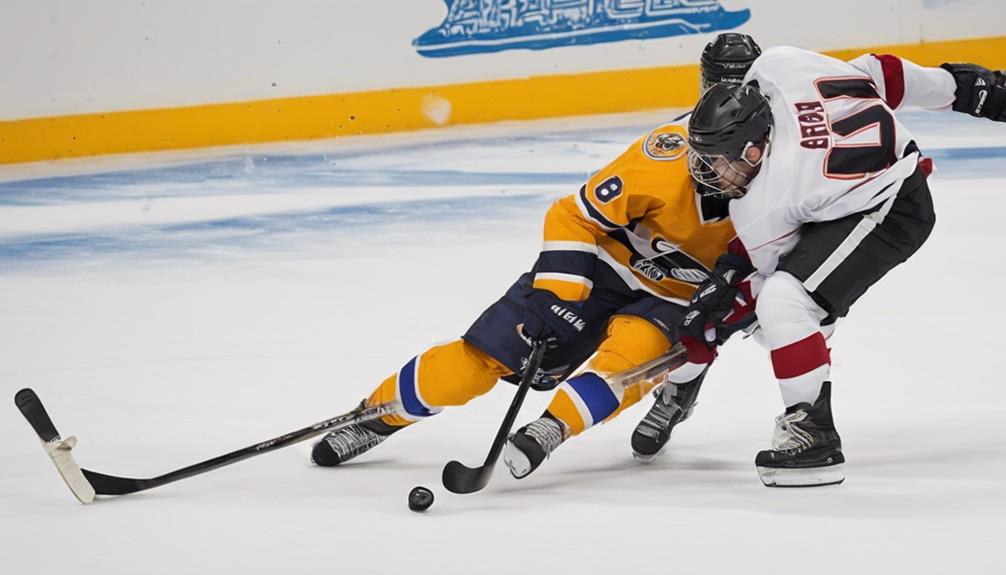Imagine this: a player deftly intercepts the puck, breaking the opponent's rhythm and setting up a potential scoring opportunity. But what goes into executing a successful takeaway? From stickwork to positioning, mastering this skill can elevate a player's performance on the ice. So, next time you watch a game, pay attention to the art of the takeaway – it's a game-changer.
Understanding Takeaways in Hockey

To understand takeaways in hockey, you need to know that they occur when a player steals the puck from an opponent. It's an essential aspect of the game that can shift the momentum by providing an offensive advantage while disrupting the opposing team's strategy.
Defensive strategy plays a significant role in executing successful takeaways. Players must anticipate their opponent's moves, position themselves effectively, and employ precise stick techniques to intercept passes or strip the puck.
Player positioning is key when attempting a takeaway. It involves being in the right place at the right time to challenge the opponent effectively. By maintaining proper positioning, a player can limit the options available to the puck carrier, increasing the chances of a successful steal.
Additionally, mastering stick technique is essential for executing clean takeaways. Using quick and agile stick movements, players can poke-check, lift the opponent's stick, or sweep in to gain possession of the puck.
Importance of Defensive Prowess
Mastering defensive prowess in hockey requires a combination of anticipation, positioning, and quick stick work to effectively disrupt the opponent's plays.
When focusing on defensive strategy, your ability to read the game, anticipate passes, and react swiftly is vital for gaining possession and stopping the opposing team's advances.
Puck possession is key in hockey, and a strong defensive game helps maintain control over the game's flow.
Here are five essential aspects to keep in mind when honing your defensive skills:
- Anticipation: Predicting the opponent's moves and adjusting your positioning accordingly.
- Positioning: Maintaining the correct stance and spatial awareness to block passing lanes.
- Stick Work: Using your stick to poke check, intercept passes, and disrupt the opponent's actions.
- Communication: Working with teammates to coordinate defensive movements and coverages effectively.
- Physicality: Knowing when to apply pressure, engage in body positioning, and make physical plays to regain possession.
Techniques for Executing Takeaways

Enhance your defensive game by perfecting the art of executing takeaways with precision and timing.
Defensive positioning and stick control are essential elements in successfully executing takeaways in hockey. When attempting a takeaway, make sure you're in the correct defensive position to intercept passes or block shots effectively. Keep your stick on the ice and use it to disrupt the opponent's plays.
Timing and anticipation play a significant role in executing successful takeaways. Anticipate where the puck carrier is likely to pass or move next, allowing you to make a well-timed move to intercept or disrupt the play. Stay focused and be ready to react quickly to capitalize on any turnovers or mistakes made by the opposing team.
Practice your defensive skills consistently to improve your ability to execute takeaways with efficiency. By honing your defensive positioning, stick control, timing, and anticipation, you can become a valuable asset to your team's defensive efforts.
Impact on Team Momentum
Reflect on the impact of takeaways on team momentum can be significant in hockey. When you successfully execute a takeaway, it can lead to momentum swings and act as game changers, altering the course of the match. These moments not only provide your team with a psychological advantage but also boost overall team confidence.
Here are some key points to ponder regarding the impact of takeaways on team momentum:
- Takeaways can create momentum swings, shifting the game's dynamics in your team's favor.
- Successful takeaways act as game changers, turning the tide of the match.
- They provide a psychological advantage by putting pressure on the opposing team.
- Executing takeaways boosts team confidence, leading to better overall performance.
- Consistent takeaways can establish a pattern of dominance, further solidifying your team's momentum and control over the game.
Statistics and Analysis of Takeaways

Analyzing the statistics of takeaways provides valuable insights into a team's defensive effectiveness and playmaking abilities. When looking at player stats, the number of takeaways can indicate a player's skill in disrupting the opponent's offense and creating scoring opportunities for their team. For teams, a high total of takeaways often correlates with solid defensive strategies and can lead to offensive benefits like increased possession time and more scoring chances.
To better comprehend the impact of takeaways, let's explore a comparison table showcasing the top players in terms of takeaways and the success of their respective teams:
| Player | Total Takeaways | Team Success |
|---|---|---|
| Player A | 65 | Playoffs |
| Player B | 53 | Division Champs |
| Player C | 45 | Bottom Ranking |
Role of Takeaways in Transition Play
Exploring the connection between takeaways and the flow of gameplay reveals the significant impact these defensive plays have on team progressions. When considering the role of takeaways in switching play style, it's crucial to understand how these defensive maneuvers influence the offensive strategy and defensive mindset of a team.
Here's a closer look at the dynamics:
- Quick Turnovers: Takeaways create instant opportunities to shift from defense to offense, catching the opposing team off guard.
- Neutral Zone Dominance: By executing successful takeaways in the neutral zone, teams can disrupt their opponent's advances and regain control of the game tempo.
- Strategic Breakouts: Takeaways fuel efficient breakouts, allowing teams to swiftly move the puck up the ice and launch coordinated attacks.
- Counterattacking Prowess: With well-timed takeaways, teams can capitalize on turnovers and swiftly mount counterattacks to catch their opponents on the back foot.
- Defensive Stability: Solid takeaway skills contribute to a team's overall defensive stability, preventing the opposition from gaining momentum and maintaining control of the game flow.
Developing Takeaway Skills

To enhance your performance on the ice, honing your takeaway skills is essential for becoming a formidable defensive force in hockey. Stick positioning and timing are vital elements to master when aiming to execute successful takeaways.
Proper stick positioning involves keeping your stick in passing lanes and close to the opposing player's stick to disrupt plays effectively. Timing is equally significant, as you need to anticipate the opponent's movements to intercept passes or disrupt their plays.
Developing defensive awareness and anticipation is key to improving your takeaway skills. Being aware of the positioning of both the puck carrier and their teammates can help you anticipate their next move and react quickly to intercept the play. Anticipation allows you to read the game better, predict plays, and position yourself strategically to make successful takeaways.
Key Players Known for Takeaways
Some players who are renowned for their exceptional takeaway abilities include those with a keen defensive instinct and precise stickwork. These players stand out for their ability to read the game, anticipate plays, and disrupt the opponent's offensive flow.
Here are some key insights to keep in mind when examining players known for their takeaways:
- Player comparisons can help highlight the defensive prowess of certain athletes.
- Defensive strategies play an essential role in a player's ability to excel in takeaways.
- Team tactics often revolve around creating opportunities for turnovers.
- Turnover control is a vital aspect of a team's overall defensive performance.
- Analyzing the top players in takeaways can provide valuable insights into effective defensive techniques.
Conclusion
So next time you watch a hockey game, keep an eye out for those skilled players making key takeaways on the ice. These defensive plays not only disrupt the opponent's offense but can also create scoring opportunities for their own team.
Remember, mastering the art of takeaways takes practice and dedication, but it can have a huge impact on the outcome of the game. Keep working on those skills and watch your game improve!




